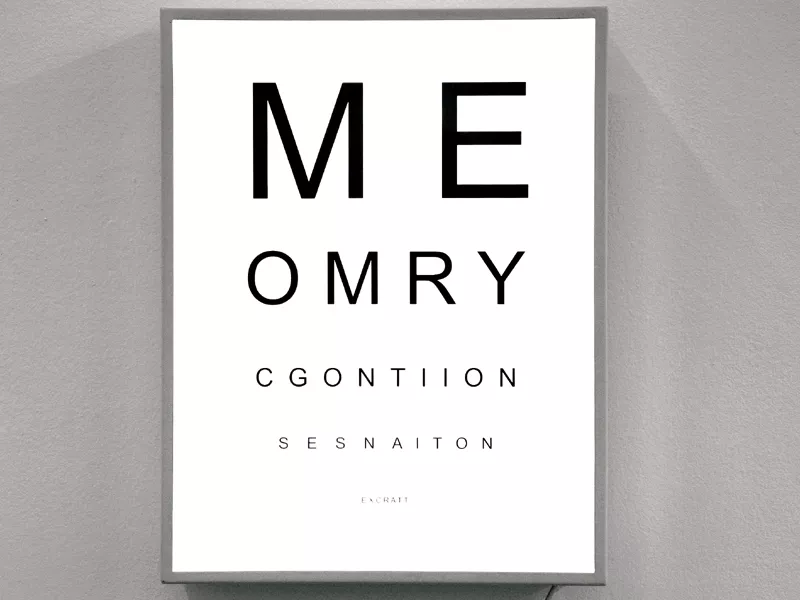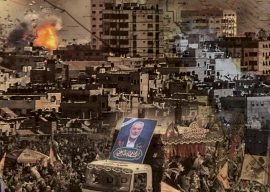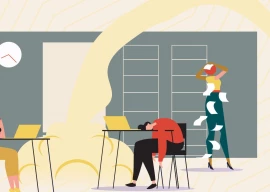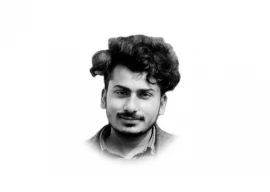
“It is about how close we can be, but how far apart we stand,” explains Gupta, who sees art as a way to understand what is around us through a media of form, light and sound. “But these mediums become the language to articulate what one comprehends or is unable to comprehend.” Indeed, given the history of relations between the members of these faiths, sometimes art is the only way to communicate.

2652-1, Installation, Archival Print on Canvas, 2010 Dimensions 1650.60 x 1.57 inches 4200.00 x 4.00 centimetres
It is works like these that have made a name for the 36- year-old, who is now taken as a star in the world of Indian art. Her works are rooted in and reflective of the times we live in. Regarded as a pioneer of New Media art, she consistently explores themes such as cultural and religious divides, globalisation and terrorism.
“The question of time, place and group that one is born into and may choose to dream or live in, has been impossible to escape,” says Gupta who has just returned from a solo exhibition in Brisbane. This has been an especially productive year. Just halfway through 2013, her works have been displayed in galleries in England, Singapore, Ireland, Denmark, New York and the UAE.
Since her student days at Mumbai’s prestigious Sir JJ Institute of Applied Arts, Gupta’s art has evolved to mine the rich tropes of time, perception of it and the measurement of distances. Despite works like 2652-1, she rejects the label of being a political artist, preferring instead to be called an “everyday” artist.
Gupta, who was born and raised in Mumbai, says her upbringing had an enormous influence on her evolution as an artist. “I grew up in a large, joint family and it was a tough decision to become an artist,” she told The Express Tribune. “While at one level, I felt great freedom with the opportunity to go to an art school, I was also aware [of] the meaning of choosing this thing called art.” Growing up in a family of 20 to 25 people in a large open home, made one aware of the “language” of art and how it could connect with those so close to it and not just to a small group of visitors coming to a gallery.
“When I was growing up, the air was full of cosmopolitanism,” she adds. “But something deep was affected in 1992 after the riots in Mumbai.” Gupta remembers a class chair that stayed empty after the riots, or seeing smoke from her terrace. That was also the decade of 9/11 and the US bombing of Iraq. She was keenly aware of those implications.

2652-1, Installation, Archival Print on Canvas, 2010 Dimensions 1650.60 x 1.57 inches 4200.00 x 4.00 centimetres
Gupta embraced art full time in 2004, after working a few years as a graphic designer. Her initial work was performance and web-based, with her later graduating to using a variety of media and forms such as video, installation and pictures. Interactivity, a hallmark from her early days, remains an abiding feature.
In one of her most talked-about works, a photographic series titled ‘I Want to Live with No Fear’, visitors were given a balloon printed with this line and photographed by Gupta as they travelled in public. Their pictures were made a permanent piece in the show.
Of closer relevance to home is the piece 1:14.9. Gupta created a hand-bound ball of thread symbolising the 1,907 kilometres, or 1,185 miles, of the border between India and Pakistan that have been fenced. The title of the work of art is the ratio of the length of the thread (79.5 miles) to the length of the fenced border.

1:14.9, 1,188.5 miles of fenced border — West, North-West Data Update: Dec 31, 2007. Hand wound thread ball and a vitrine, 2011-12 22x20x62 in | 56x51x158 cm
While her pieces are often specific to certain issues or conflicts, Gupta is constantly exploring ways to connect with her viewers, to encourage them to question their biases and engage with global concerns in a more personal way. It is perhaps this quest that gives her art a certain accessibility and appeal, sometimes absent in other works dealing with similar issues.
Her works range between Rs25,000 and Rs200,000, depending on the scale and medium.
Published in The Express Tribune, Sunday Magazine, August 18th, 2013.
Like Express Tribune Magazine on Facebook, follow @ETribuneMag on Twitter to stay informed and join the conversation.


















COMMENTS
Comments are moderated and generally will be posted if they are on-topic and not abusive.
For more information, please see our Comments FAQ